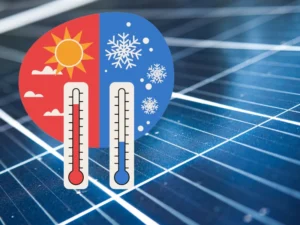Effect of Temperature on Solar Panels
Solar power is a renewable source of electricity but like wind power it is subject to weather conditions. In fact, the performance of solar panels can be greatly affected by temperature. In this article, we will examine how the effect of temperature on solar panels. We will also find out how to strike a balance to maximize the energy efficiency of photovoltaic installations.

The Effect of Low Temperatures on a Solar Panel.
The one problem that low temperatures can cause is the shrinkage of materials inside solar panels. When the temperature drops quite a bit below 0 degrees Celsius, mechanical stresses may be created that can damage the panels in the long run.
Otherwise, cold weather normally increases their output. Snow, unless there is a lot of it to prevent irradiation, also increases the yield.
In fact, the albedo effect can increase yield by as much as 20 percent.
The Effect of High Temperatures on Solar Panels
High temperatures, on the other hand, are certainly more problematic than low temperatures. At high temperatures, the materials inside photovoltaic panels become less conductive. This is true for all conductive materials. This means that photons, the particles of sunlight, may have difficulty releasing electrons into the semiconductor materials that form the panels, causing less current to flow and thus a loss of efficiency in power generation.
While the ideal temperature is 25 degrees Celsius, on average the loss is 0.4 percent for every degree more. This means that at 35 degrees we already have a 4% loss.
Finding a Balance: The Optimal Temperature
As mentioned earlier, the optimal temperature for PV modules is between 24 and 25 degrees Celsius. However, in hot summers or cold winter climates, this ideal temperature can be difficult to achieve.
To maximize the performance of PV panels, many installations include passive or active cooling systems to keep panel temperatures within an optimal range.
Using cables that are as short as possible always helps to decrease leakage in DC installations, and insulating them is always a good idea.
The angle of inclination and orientation of the panels can also affect the operating temperature and, consequently, the performance of the system. Optimizing these variables while obviously taking latitude into account can help minimize the impact of extreme temperatures.
To conclude, the energy produced from all renewable sources depends greatly on system optimization and climate analysis.

